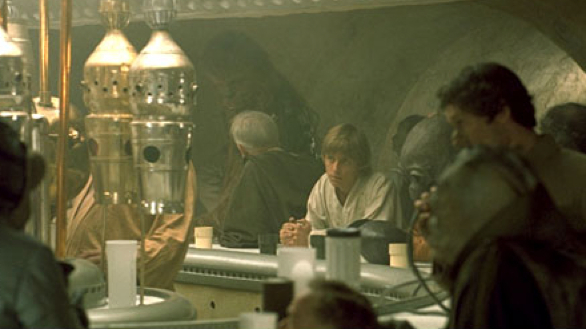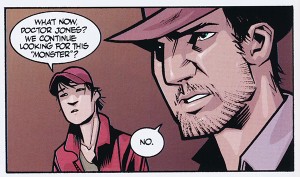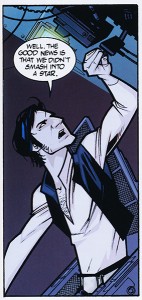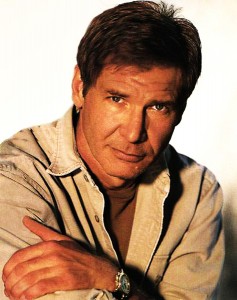
Okay, maybe not favorite, but as far as morally ambiguous asthmatic cyborgs go, Anakin Skywalker is at the very top.
If you doubt his superhero creds, do the checklist yourself. Superpowers? That lightsaber would be plenty, but he could also go head-to-baldhead with Professor X in a telekinetic wrestling match. Secret double identity? Vader/Skywalker is self-explanatory, and if it wasn’t a secret there’d be no Episode 5 shocker: “Luke, I’m your father!” Masked costume? Can’t get more masked than a grill-mouthed, aviator-lensed Samurai helmet. Plus he struts around in a cape.
Of course the main objection to Vader joining the Guardians of the Far Far Away Galaxy isn’t wardrobe or weapon related. It’s his mission: eradicate all Jedi knights, his Galaxy’s actual Guardians. In fact, it would seem to put him near the top of the supervillain roster, just under his evil mentor, Emperor Palpatine.
But Anakin was born with a larger mission: to bring balance to the universe. He is the highest manifestation of the Force, the immaculately conceived uber-child of the midi-cholorians, those symbiotic lifeforms that surge in the cells of all Jedis. In fact, he has the highest midi-cholorian blood count ever recorded, 20,000 per cell, eight times higher than the 2,500 of mere humans (yeah, I couldn’t stomach Episode One either).
So Anakin is the Chosen One, the guy foretold by ancient legend—basically King Arthur or a laser-wielding Jesus Christ. But what exactly does the prophecy mean? According to the Jedi, those evil Sith lords throw the Force off balance and so it’s a Jedi’s duty to battle them. Thus the Chosen One would “destroy the Sith and bring balance to the Force.” Sounds good, but that’s not exactly the happy ending they got.
Episode Three wedges in the unfortunate phrase “the Jedi and then” between “destroy and “the Sith.” Does that mean the Force and its microscopic avatars are all metaphysical morons? Oops. Sorry about the annihilation of your entire Jedi Order. Our bad. Thanks for worshipping us though.
I think the Jedi read their prophecies through Jedi-tinted glasses. I think the Force was tired of them and the Sith see-sawing the universe on its back. A never-ending battle between good and evil is fun and all, but after 25,000 years maybe that Manichean match-up starts looking like the problem, not the solution. If war is the enemy, then all warriors, Sith and Jedi alike, are obstacles to peace.
So the Force took things into its microscopic hands, impregnated an unsuspecting slave woman, and released the biggest Force-wielding superhero of them all, letting him and his Sith boss slaughter every Jedi knight in existence, except for his first mentor who chops off three-quarters of his limbs while dunking him in a river of lava, after which his lying boss clamps him into a wheezing cyborg suit. That’s all in the fine print of the Chosen One job description.
Then the Force chills for a couple of decades, letting the Sith-administered Empire explode a few planets and whatnot, until the Chosen One gets around to offing mentor number two, plus himself in the lightning-discharging process, and so finally destroying the conveniently tiny two-guy Sith Order. End of all Force manifestations in the known universe. Balance Accomplished.
That is until the Empire of Disney assumed control of the Lucas Republic and released Darth Abrams on the Star Wars franchise. Episode Seven awakens the Force on December 18th, overturning all of Anakin’s brutally hard work. The guy sacrificed everything for the greater good, and now that little punk son of his, Luke, has been rebuilding the damn Jedi order, throwing the Force off balance again? If I were a midi-cholorian, I’d be pretty pissed right now!
Although George Lucas originally said he had three trilogies in mind, he later admitted the third was less prophecy and more publicity. The catastrophically bad prequels were always more-or-less part of the implied backstory, but he just thought it sounded cool to say later sequels would parallel the actors’ actual ages. Thus Luke Skywalker and Mark Hamill are both 63 now. That’s adorable and all, but not exactly the premise for a three-film blockbuster extravaganza.
In other words, the Force and the creator of the Force both considered the story over. But director J. J. Abrams is a good choice for beating a dead sci-fi horse back to life. He yanked the Star Trek franchise back into existence too, even dragging the late Leonard Nimoy into his parallel continuum reboot. I expect no less from his reborn Star Wars.
Though I do hope he’s noticed that Mr. Hamill bears more than a little resemblance to Senator Palpatine these days. Could it be mere coincidence that the ex-Jedi has made a post-Star Wars career voicing animated supervillains, including that uber-Sith Lord, the Joker?
Sadly, the universe’s greatest superhero, Darth Vader, won’t be there to save the day again.








